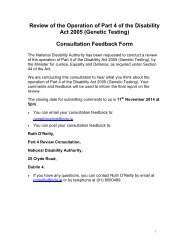advances
s8qx303jAhT
s8qx303jAhT
Create successful ePaper yourself
Turn your PDF publications into a flip-book with our unique Google optimized e-Paper software.
PHYSICS<br />
<strong>advances</strong><br />
Hydrogen, made of a proton<br />
and an electron, is the<br />
most abundant element<br />
in existence, and it is hard<br />
to imagine life without it.<br />
According to the Standard<br />
Model, the physics theory<br />
that explains how the basic<br />
building blocks of matter<br />
interact, an equal amount<br />
of matter and antimatter<br />
formed at the birth of the<br />
Universe.<br />
Big Bang balance<br />
World-leading experiment takes<br />
measurements of the properties<br />
of antihydrogen<br />
However, almost no antimatter can be found<br />
today. Unless we make it ourselves, there<br />
is no sign of antihydrogen, the antimatter<br />
counterpart of hydrogen, but nobody knows<br />
why.<br />
Matter and antimatter annihilate upon<br />
contact; if there was ever a balance,<br />
we wonder why there is almost no<br />
antimatter left at all. This is a serious<br />
puzzle for physicists, because symmetry<br />
is so central to the way that nature is<br />
understood.<br />
The Standard Model also says that during<br />
the Big Bang, equal amounts of antimatter<br />
and matter were created. Therefore, the<br />
current model predicts that we should<br />
not be here to ask this question at all. The<br />
theory that the Universe is composed of half<br />
matter and half antimatter would mean that<br />
everything was annihilated and we would<br />
never have existed.<br />
Physicists from Swansea University’s<br />
College of Science, together with<br />
colleagues from the international ALPHA<br />
collaboration at CERN, are using stateof-the-art<br />
techniques to address as many<br />
aspects of antimatter as possible in order to<br />
determine if there is a difference between<br />
antimatter and matter that can explain this<br />
conundrum.<br />
Their research has found a new limit on<br />
the charge of antihydrogen atoms, which<br />
was obtained by ‘tickling’ the anti-atoms<br />
while they were held in a magnetic bottle.<br />
This world-leading experiment is the first<br />
that has done any measurements of the<br />
properties of antihydrogen. In previous<br />
experiments, the researchers have obtained<br />
a first glimpse of its internal structure, by<br />
manipulating a property called the spin of<br />
the antielectron.<br />
The aim of the studies is to move forward<br />
our understanding of why we are here, and<br />
how the Universe could evolve from the<br />
Big Bang to today in the way it has done.<br />
Matter-antimatter symmetry lies at the<br />
heart of this endeavour.<br />
In this experiment, physicists studied the<br />
antihydrogen atoms by first combining<br />
an antiproton and a positron (the<br />
antimatter equivalent of an electron) to<br />
make antihydrogen, which they trapped<br />
in a magnetic field. They then kicked the<br />
trapped particles with an electric field to<br />
see if they would react. If an antihydrogen<br />
reacts and escapes from the trap, this<br />
means it has a charge; if it doesn’t then it’s<br />
neutral.<br />
As no atoms escaped, the researchers<br />
concluded that the limit on the possible<br />
charge of the antihydrogen atom was<br />
less than about one billionth of that of an<br />
electron.<br />
To move forward, the researchers plan<br />
to measure the internal properties of<br />
antihydrogen, and measure the gravitational<br />
force on antihydrogen.<br />
Profile<br />
Profile<br />
Product<br />
Antimatter research experiment<br />
Applications<br />
Exploring antihydrogen atom<br />
properties<br />
Contact<br />
Niels Madsen<br />
Department of Physics<br />
College of Science<br />
Swansea University<br />
Singleton Park<br />
Swansea SA2 8PP. UK<br />
T: +44 (0) 1792 602 652<br />
E: n.madsen@swansea.ac.uk<br />
W: www.swansea.ac.uk<br />
20<br />
<strong>advances</strong> wales<br />
Issue 78/Spring 2016 20




